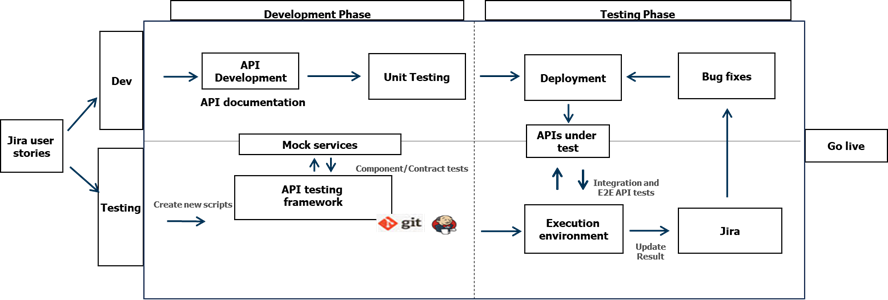Microservices architecture segregates applications into loosely coupled services that communicate over APIs. This introduces several testing challenges:
1. Microservices Interactions (service to service communication)
Each microservice may depend on multiple APIs. A failure in one can cascade across the system. API testing ensures that the
- Endpoints are reachable.
- Payloads conform to schema.
- Services handle failures gracefully.
2. Contract Testing
Tools like Pact or Spring Cloud Contract help validate that the consumer and provider agree on the API contract. This prevents integration issues during deployment.
3. Performance and Load Testing
APIs must scale under load. Testing tools simulate concurrent users to measure:
- Response time.
- Throughput.
- Error rates under stress.
4. Security Testing
APIs are often the attack surface. Security testing validates:
- Authentication (OAuth2, JWT).
- Authorization (role-based access).
- Input validation (SQL injection, XSS).
Tools for API Testing: Postman, Bruno, RestAssured, Karate and more
Postman
A GUI-based tool ideal for exploratory and automated testing.
Key Features:
- Easy to create and chain requests.
- Supports scripting with JavaScript.
- Integrates with CI/CD via Newman CLI.
- Visualizes test results and response times.
Use Case: Great for manual testers, QA engineers, and quick validations.
Bruno
A modern, open-source GUI-based API client designed for developers and testers.
Key Features:
- Lightweight and fast with a native desktop experience.
- Supports environment variables and scripting with JavaScript.
- Git-friendly: stores requests and collections as plain text files.
- Works offline and integrates well with version control systems.
Use Case: Ideal for developers and testers who prefer a fast, open-source alternative to Postman with better Git integration and offline capabilities.
RestAssured
A Java-based DSL for testing REST APIs, often used in backend automation suites.
Key Features:
- Fluent syntax for request/response validation.
- Supports JSONPath and XMLPath.
- Integrates with JUnit/TestNG.
- Ideal for BDD with Cucumber.
Use Case: Best for Java-heavy projects and integration into backend test frameworks.
Karate
An open-source framework that combines API testing, mocking, and performance testing.
Key Features:
- BDD-style syntax with no Java coding required.
- Built-in support for JSON/XML assertions.
- Parallel execution and mocking.
- Performance testing with Gatling integration.
Use Case: Ideal for teams looking for a unified, low-code API testing solution.
Integrating API Testing into CI/CD
To fully embrace DevOps, API tests must be automated and integrated into the pipeline:
- Pre-merge: Run contract and unit-level API tests.
- Post-deploy: Run smoke and regression tests.
- Scheduled: Run performance and security scans.
Tools like Jenkins, GitHub Actions, and GitLab CI can trigger API tests using Postman (via Newman), RestAssured (via Maven/Gradle), or Karate (via CLI).
Sample Approach
Figure:1

Metrics that could be tracked for capturing efficiency
To measure the effectiveness of API testing, track:
- Test Coverage: % of endpoints and scenarios tested.
- Mean Response Time: Average latency under normal load.
- Error Rate: % of failed requests.
- Contract Violations: Number of schema mismatches.
- Security Findings: Number of vulnerabilities detected.
These metrics help teams prioritize improvements and demonstrate ROI.
Final Thoughts
API-first testing is not just a trend—it’s a necessity in the modern software delivery landscape. As microservices grow in complexity, the need for robust, automated, and continuous API testing becomes paramount.
By leveraging tools like Postman, Bruno, RestAssured, and Karate, and embedding testing into the CI/CD workflows, we can ensure the APIs are not just functional, but resilient, performant, and secure

 English | EN
English | EN 